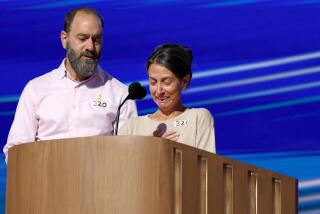‘Standard Operating Procedure’
“STANDARD OPERATING PROCEDURE” is not the first documentary on Iraq. It’s not the first film on America’s embrace of torture as a weapon of choice. It’s not even the first picture to focus on the notorious Abu Ghraib prison. What it is is the first time Errol Morris has looked at these issues, and that makes the difference.
Morris, one of the world’s premier documentarians and an Oscar winner for “The Fog of War,” has done something quite unusual. He’s taken the prison everyone’s heard of, the photographs everybody’s seen and the torture that people are either ashamed of or in denial about and looked at it all with such a fierce specificity that to experience “Standard Operating Procedure” is to feel as if we haven’t focused on those things at all.
And focus is really the heart of Morris’ unsettling film, which strikes a remarkable balance between art and disturbance, between beauty and pain. “Standard Operating Procedure” is the result of two years of investigation by Morris and his team, which produced and pored over a search that garnered a million and a half words of transcript, tens of thousands of pages of documents and more than a thousand photographs.
For the first time in a feature, we hear testimony from five of “the seven bad apples,” the MPs from the 372nd Company who were prosecuted for what happened at Abu Ghraib, including the three women -- Lynndie England, Megan Ambuhl and Sabrina Harman -- who were sentenced for their conduct. Perhaps more chilling, though for unexpected reasons, is the testimony of Brent Pack, a special agent for the military’s Criminal Investigations Division, the man who analyzed the photographs for the Army.
“Standard Operating Procedure” not only lets us listen, it shows us things, things we’d prefer not to see. Dozens of those disturbing, difficult-to-take Abu Ghraib photographs, including devastating shots of a man who was killed during interrogation, are put up on screen so we can see as well as hear what was going on. It is not an easy journey to take.
Director Morris (who paid some of his interviewees) also makes use of artful re-creations, showing us not-always-expected moments, from snarling dogs to a closeup of eyebrows being shaved. When combined with Danny Elfman’s insinuating score, the careful formal beauty of these scenes (Robert Chappell and Robert Richardson are the cinematographers) makes the horrors they depict that much more horrific.
The goal in all of this is to take us inside the Abu Ghraib experience, to pile on excruciating detail and dig deeply into the core of the story, to make us not just see the pictures but also understand the world and the mind-set they came out of.
What we find is that the stage was already set at Abu Ghraib and the play in progress by the time this cast of characters arrived. Far from being so-called bad apples, the seven indicted MPs (the two who are not on camera, including Charles A. Graner Jr., were in prison and not made available) were simply the terribly unlucky group whose hands were caught in the cookie jar. As Harman says, “The example was set when we got there. It was OK.”
Aside from Harman, whose letters home talk about her “bad feeling about this place” and who ended up being the bright-eyed, thumbs-up woman in many of the photos, the most memorable individual talked to is England. She became the worst kind of international celebrity after being photographed holding a leash attached to the neck of a cowering Iraqi prisoner.
A palpable sadness and powerlessness envelopes England, as it does the other convicted MPs, a sense of the unfairness they feel at being singled out for pervasive group behavior. Like the heroine of a country song, England, the then girlfriend of Graner, who is now married to fellow indictee Ambuhl, puts it all down to the pernicious influence of the opposite sex. “Every single woman in the brig with me was there because of a man,” she says unhappily. “I was blinded by being in love with a man.”
Though its view of how easily ordinary Americans can get accustomed to acting abysmally is one of the unsettling elements of “Standard Operating Procedure,” its greatest shock, and the explanation for its title, comes near the close.
That’s when CID investigator Pack takes us through those notorious photos and dispassionatately points out which were criminal acts of torture and which, no matter how dreadful they looked, were business-as-usual humiliation.
The fact that it takes an expert to differentiate torture from standard operating procedure is a terrifying thought indeed.
“Standard Operating Procedure.” MPAA rating: R, for disturbing images and content involving torture and graphic nudity, and for language. Running time: 1 hour, 57 minutes. Playing at the Sunset 5 (Hollywood), the Playhouse 7 (Pasadena) and the Town Center 5 (Encino).
More to Read
The biggest entertainment stories
Get our big stories about Hollywood, film, television, music, arts, culture and more right in your inbox as soon as they publish.
You may occasionally receive promotional content from the Los Angeles Times.











